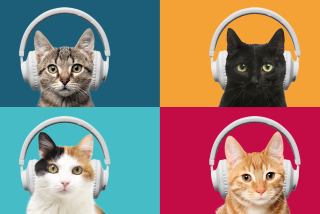SiriusXMâs winning niche playlists
NEW YORK â Perched on the 36th floor of a Manhattan skyscraper, SiriusXM Radio Inc.âs glass-walled lobby teemed with 52 buff bachelors, a diminutive Catholic nun and singer Chris Isaak strumming his guitar, a pint-sized white terrier at his heels.
As Isaak crooned songs from his country album âBeyond the Sun,â Billy Corgan was in an adjacent studio promoting the re-release of his indie rock band Smashing Pumpkinâs first two albums. Minutes later, shock jock Howard Stern sauntered down the hallway from his recording studio to a private service elevator that leads to his ride.
It was just another morning at SiriusXM, which dishes out an eclectic and complex blend of 180 satellite radio channels to almost 22 million customers across North America. Last year, it took in $3 billion in sales and dethroned Clear Channel Media as the largest radio company in the U.S. by revenue.
But in this volatile corner of the media, SiriusXM faces a set of digital music competitors such as Pandora, Spotify, Slacker and Rhapsody that allow listeners to build custom stations to fit their own tastes. Clear Channel also is hitting back with its own personalized digital music service, called iHeartRadio. Those services have grown up primarily on the Web and mobile devices, where Sirius has but a small presence. Now, theyâre slowly muscling into SiriusXMâs stronghold â the car.
SiriusXM plans to beat these newcomers the same way it conquered FM radio â with what it advertises as cool programming and hot personalities.
âSirius was built for artistic expression through niche programming,â said Steven Van Zandt, the E Street Band guitarist and impresario of âLittle Stevenâs Underground Garage,â a SiriusXM channel that draws on Van Zandtâs selected roster of 4,000 songs to illustrate the history of rock ânâ roll. âIâll play Sam Cookeâs version of âGood Timesâ and follow that up with the Rolling Stonesâ version of it. Itâs a deeper dive than you can get on broadcast radio stations. Iâve always thought that the depository of our entire musical history will end up on SiriusXM.â
Satellite radio developed in part as a backlash to the homogenization of FM radio in the U.S., in which the playlists at a Los Angeles station differed little from those in Santa Fe, N.M., or Pittsburgh. SiriusXM, the result of the 2008 merger of competing satellite radio services Sirius and XM, responded with channels devoted to genres, subgenres and individual singers and bands. (Los Angeles Times Publisher Eddy Hartenstein has served as chairman of the SiriusXM board since 2010.)
Much the way that cable TV has grown through niche marketing, Sirius has five channels devoted to different types of country music, 24 for rock and 19 for Latino music, talk and sports. There are channels devoted entirely to music from each decade from the 1940s through the 2000s. Broadway show tunes have a dedicated channel, as does opera.
Personalities also are key to the formula. Martha Stewart, Jamie Foxx, skateboarder Tony Hawk, controversial shock jocks Opie and Anthony and Sister Marie Pappas share the dial. Add to that a steady stream of guests who flow through its SiriusXMâs lobby, such as the 52 bachelors who breezed in for a segment on âCosmo Radio,â on which Sirius partners with Cosmopolitan magazine publisher Hearst Corp., and the atmosphere can get downright surreal. The day Pappas interviewed a survivor of the 1994 Rwandan genocide for her show on the Catholic channel, actor Tom Papa brought in comedian Dave Attell to riff on the evolution of pornography on the Raw Dog channel, devoted to uncensored comedy.
SiriusXM also serves up a broad representation of news and talk across the political spectrum from Glenn Beck to former âCrossfireâ co-host Bill Press, plus special events such as a recent subscribers-only Bruce Springsteen concert from the Apollo Theater in New York. The company also takes its sports seriously, including broadcasting live play-by-plays of all NFL, NBA and major league baseball games.
Many of the hosts are refugees from traditional broadcast radio, including longtime Los Angeles DJ Jim Ladd, who landed at Sirius in January after being laid off from KLOS-FM (95.5). Most are happy that they have found a place where they can indulge their niche interests.
For Ladd, that is a radio format called free form, where the DJ has total freedom to play whatever he or she wants. Ladd, whose pioneering work as a free-form programmer inspired the Tom Petty song âThe Last DJ,â said: âTerrestrial has turned its back on what rock ânâ roll is all about, which is freedom. What was once a creative and rebellious art form has become a boring, repetitive machine. Rock is supposed to be fun. Itâs supposed to be unpredictable. And itâs supposed to be a little dangerous. And SiriusXM is re-revolutionizing rock radio by giving me more freedom than Iâve ever had.â
Jose Mangin, program director for Octane and Liquid Metal, channels devoted to heavy metal rock, has been with SiriusXM for 11 years, and he said he stays with the company because it lets him âgeek out.â
âThere needs to be a soul beneath the machine,â Mangin said, his hair razor-spiked, chunky silver rings on his fingers. âHere, I can program for superfans like me. Thereâs a person behind all the songs we play, not some computer.â
That was a gibe at SiriusXMâs competition, music streaming services whose playlists are programmed not by DJs but by computer algorithms and which pose the most serious long-term threat to the company.
Oakland-based Pandora already has more than 40 million active listeners â though only 4 million are paying subscribers. Spotify has 10 million customers worldwide, with about 3 million paying for premium service. While Pandora has relied on smartphones for its growth spike, Spotify is leveraging Facebook to gather customers.
Both have begun taking a cue from SiriusXMâs beginnings to challenge the dominant radio provider. Just as SiriusXM used the advent of satellite delivery to the dashboard to become the onboard radio of choice for drivers across America, so now are its competitors beginning to filter their way into cars rolling off the assembly line.
âSirius had the advantage of being installed directly into the car,â said Russ Crupnick, an analyst with NPD Group Inc., a market research firm. âAs you start to see other technologies get into the dashboard, that advantage will evaporate.â
Already, millions of people plug their smartphones into their car stereos to stream Pandora, Spotify and other free music services that cater to their personal tastes. A button on the dashboard will make it even easier. Auto manufacturing cycles are notoriously long, and it could be years before a majority of cars on the road are equipped with in-dash options for streaming digital music. But few doubt that that day is coming.
One floor up from the cultural United Nations that is the SiriusXM lobby, the companyâs chief executive, Mel Karmazin, says he believes SiriusXM will win because of its deep, segmented approach to music and talk shows, not its delivery mechanism.
âAt the end of the day, content is what will prevail,â said the 68-year-old former CBS Corp. chief executive and president of Viacom Inc.
Karmazin is betting on it. This year, the company upped the price of its basic subscription plan from $12.95 to $14.49 a month. It was a risky move, balancing the need for higher cash flow while expanding its subscriber base.
But SiriusXM is also eager to avert a replay of the near financial catastrophe that occurred in 2009 when a large portion of its $2.8 billion in high-interest debt came due and executives considered filing for Chapter 11 bankruptcy protection. It struck a last-minute deal to sell 40% of its stock to Liberty Media Corp. for $530 million.
Partly freed from its debt, the company has since stabilized. Last year, SiriusXM reaped a profit of $427 million. Its stock, which traded as low as 10 cents in early 2009, has traded above $2 this year. Revenue climbed 7% in 2011, having risen 14% in 2010.
Rather than suffer through a bad economy, Karmazin saw a way to turn it to his companyâs advantage. Noticing that used-car sales had been taking off, SiriusXM in the last two years recruited more than 4,000 used-car dealers to sell the service, using the same free-trial techniques they offer on new-car sales.
As a result, the company will most likely exceed its goal to expand its subscriber base by 6% this year, said Agata Kaczanowska, a radio industry analyst with Ibis World, a research firm in Santa Monica, who estimated that about 45% of the people who start the three-month free trial offered by Sirius become paying customers.
For Karmazin, however, those sales incentives wouldnât be worth much if the company didnât have the content to back up the service. That means doling out hard cash for exclusive entertainment, whether itâs Sternâs five-year contract, reportedly worth $400 million, or in-house broadcast concerts by artists such as Norah Jones and Coldplay.
âWe want our subscribers to know this is a living, breathing creative environment,â said Scott Greenstein, SiriusXM president and chief content officer. âIf you mechanize content, youâve lost the essence of content. Itâs a human art form.â
More to Read
The biggest entertainment stories
Get our big stories about Hollywood, film, television, music, arts, culture and more right in your inbox as soon as they publish.
You may occasionally receive promotional content from the Los Angeles Times.










